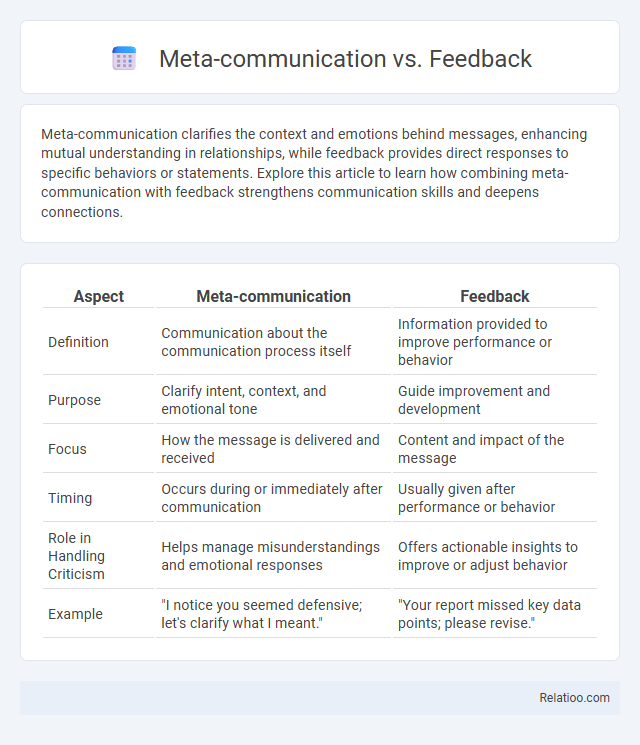Meta-communication clarifies the context and emotions behind messages, enhancing mutual understanding in relationships, while feedback provides direct responses to specific behaviors or statements. Explore this article to learn how combining meta-communication with feedback strengthens communication skills and deepens connections.
Table of Comparison
| Aspect | Meta-communication | Feedback |
|---|---|---|
| Definition | Communication about the communication process itself | Information provided to improve performance or behavior |
| Purpose | Clarify intent, context, and emotional tone | Guide improvement and development |
| Focus | How the message is delivered and received | Content and impact of the message |
| Timing | Occurs during or immediately after communication | Usually given after performance or behavior |
| Role in Handling Criticism | Helps manage misunderstandings and emotional responses | Offers actionable insights to improve or adjust behavior |
| Example | "I notice you seemed defensive; let's clarify what I meant." | "Your report missed key data points; please revise." |
Understanding Meta-communication: A Brief Overview
Meta-communication refers to the underlying messages conveyed beyond the literal content of communication, often revealing emotions, attitudes, or relational dynamics. Feedback is the direct response or reaction to a message, focused on evaluating or improving the content or behavior. Understanding meta-communication helps you interpret hidden signals in conversations, enhancing your ability to navigate complex interpersonal interactions effectively.
What is Feedback? Definition and Core Elements
Feedback is information provided to you about your performance, behavior, or work aimed at improvement and growth. Core elements of feedback include clarity, specificity, timeliness, and constructiveness, ensuring the message is understandable and actionable. Meta-communication, unlike feedback, involves discussing the communication process itself to enhance mutual understanding and interaction.
Key Differences Between Meta-communication and Feedback
Meta-communication involves the underlying messages about how communication should be interpreted, such as tone, context, or nonverbal cues, whereas feedback specifically refers to the direct response or information given about a previously communicated message or behavior. Key differences include meta-communication guiding the framing and understanding of communication processes, while feedback centers on evaluating or improving specific actions or statements. Meta-communication often shapes the effectiveness of feedback by clarifying intentions and expectations within the interaction.
Functions of Meta-communication in Interpersonal Communication
Meta-communication serves as the underlying message about how communication should be interpreted, clarifying meanings and managing relational dynamics in interpersonal exchanges. Unlike straightforward feedback, which provides evaluative or corrective responses to behavior or content, meta-communication shapes the context, tone, and intent, helping You navigate misunderstandings and enhance mutual understanding. This function is critical in regulating emotions, signaling relational boundaries, and fostering deeper connection beyond the explicit verbal content.
The Role of Feedback in Effective Communication
Feedback plays a crucial role in effective communication by providing clear information on how messages are received and understood, allowing you to adjust and improve your interactions. Unlike meta-communication, which addresses the underlying context and meaning of messages, feedback focuses on the specific response to the communication content itself. Your ability to interpret and respond to feedback enhances clarity, reduces misunderstandings, and fosters meaningful dialogue.
Examples of Meta-communication in Everyday Conversations
Meta-communication involves discussing the communication process itself, such as clarifying tone or intent, which differs from feedback that focuses on the content of the message. Examples of meta-communication in everyday conversations include statements like "I feel like you're upset," "Are you joking or being serious?" and "Let's pause to understand each other better," helping You navigate misunderstandings. This approach enhances clarity and fosters deeper mutual understanding in interactions by addressing the unspoken context behind words.
Types of Feedback: Positive, Negative, and Constructive
Types of feedback encompass positive, negative, and constructive forms, each playing a vital role in communication dynamics. Positive feedback reinforces desirable behaviors, encouraging continued performance, while negative feedback highlights areas needing improvement without necessarily providing solutions. Constructive feedback combines critique with actionable advice, enabling you to understand specific issues and develop strategies for growth through meta-communication channels.
How Meta-communication Enhances Feedback
Meta-communication enhances feedback by clarifying the underlying intent, emotional tone, and context of the message, ensuring the receiver accurately interprets the content. This process minimizes misunderstandings by addressing nonverbal cues and communication styles, enabling more effective and constructive feedback exchanges. Integrating meta-communication fosters a deeper mutual understanding, improving both the delivery and reception of feedback in interpersonal and organizational settings.
Common Misunderstandings: Meta-communication vs Feedback
Common misunderstandings between meta-communication and feedback often arise from confusing their distinct roles in communication. Meta-communication refers to the underlying messages about how communication is being conducted, such as tone, context, or body language, whereas feedback is a direct response to the content of the message itself. Misinterpreting meta-communication as feedback shifts focus away from the explicit information exchange, leading to ineffective communication and unresolved conflicts.
Best Practices for Combining Meta-communication and Feedback
Effective communication hinges on balancing meta-communication--discussing the communication process itself--with direct feedback to foster clarity and understanding. You should create an environment where meta-communication signals, such as tone and body language awareness, complement constructive feedback for enhanced interpersonal dynamics. Integrating these practices helps in identifying misunderstandings early, ensuring that your messages are accurately received and addressed.

Infographic: Meta-communication vs Feedback
 relatioo.com
relatioo.com